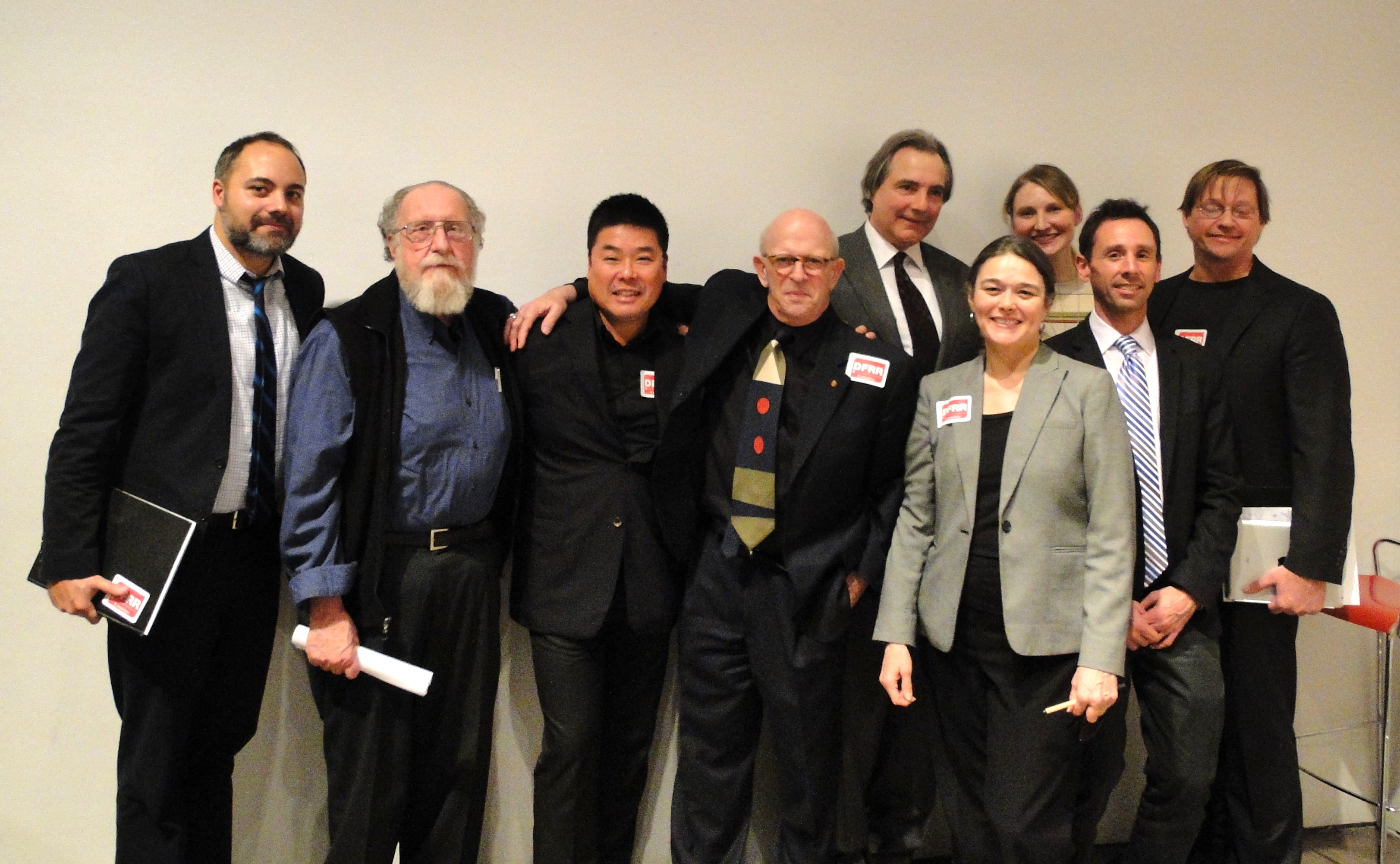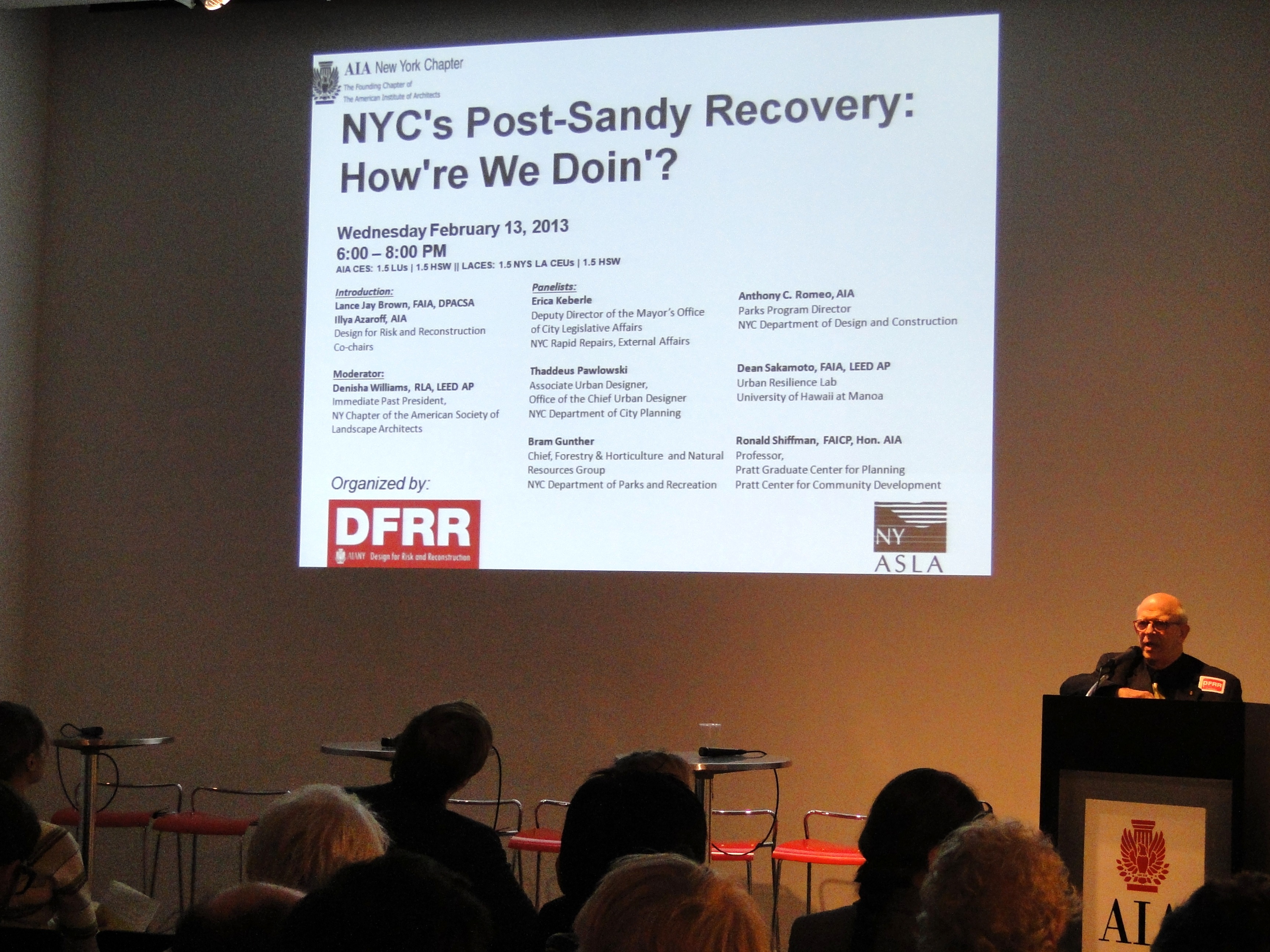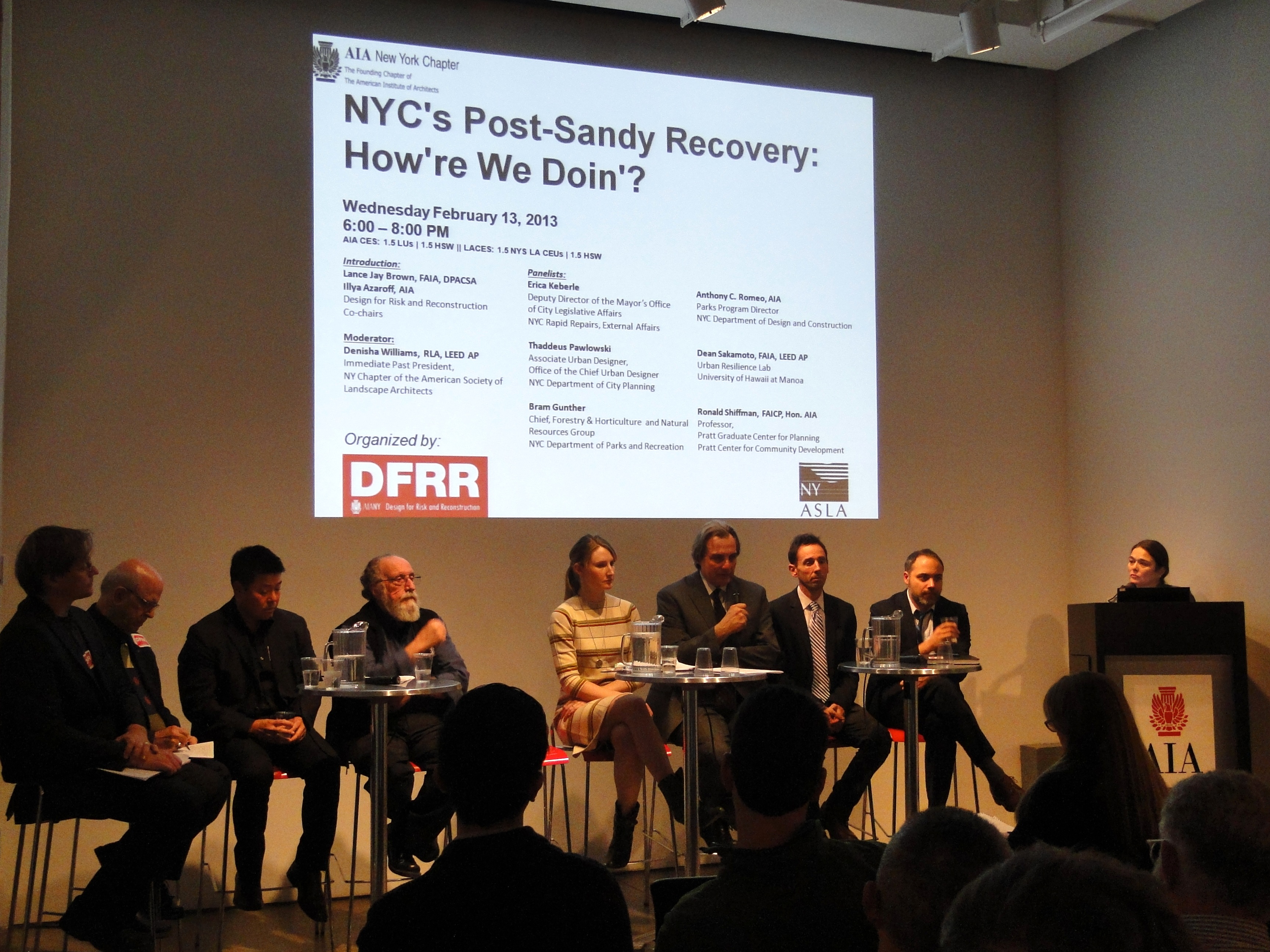by: Bill Millard
With a nod to the late Mayor Ed Koch’s reality-checking tagline, on 02.13.13 the AIANY Design for Risk and Reconstruction Committee (DfRR) assembled local and national emergency-management experts to consider the city’s performance during Superstorm Sandy and the implications for that storm’s inevitable successors.
Sandy struck just eight days after DfRR’s 10.21.12 planning panel, recalled moderator Denisha Williams, RLA, LEED AP, underscoring the urgency of this committee’s mission and the timeliness of its work in marshaling volunteers and disseminating information. The rising frequency of extreme weather events calls for continual improvement in both recovery procedures and preparations; each disaster is also a fresh information base from which everyone affected can learn.
[Editor’s Note: click here for more information on AIANY’s Post-Sandy Initiative, along with event listings and other information from related organizations and institutions.]
The answer to “How’re we doin’?” thus takes a complex “good news/bad news” form. Greater New York has bounced back from Sandy surprisingly quickly in some respects, while the darker aspect is twofold: resilience is far from universal, and it’s virtually certain that we will go through something like this again.
Sandy was not officially designated a hurricane by National Weather Service criteria because of wind speeds below 75 mph at landfall, but damage ignores semantic distinctions. The unusual hybrid storm and ensuing surge (a single-hazard event, but a powerful one) left the Rockaways, Staten Island, the Jersey Shore, and other areas with widespread devastation, ultimately far graver than Manhattan’s photogenic blackout and transit disruptions.
Still, Sandy was not Katrina, and most of the New York region has been distinctly more resilient than New Orleans. One reason is the New Orleans experience itself. Mistakes such as the widespread use of subpar housing trailers by the Federal Emergency Management Agency (FEMA) after Katrina, noted mayoral spokesperson Erika Keberle, have yielded a core principle in post-disaster situations: instead of extended relocation, she said, “one of the best solutions for temporary housing is to get people back into their homes as soon as possible so that we can start rebuilding those communities.”
The city’s Rapid Repairs program has consequently focused on the essentials: restoring electricity, heat, and hot water at no charge to homeowners, while leaving other important processes such as mold abatement for the longer run. This has opened the program to New York Post potshots, compounded by difficulties in mobilizing enough plumbers and other key workers quickly enough to reach the ambitious original goal of repairing some 12,000 to 15,000 homes by the end of 2012 (announced by Mayor Bloomberg on 11.09.12).
Still, efforts have ramped up dramatically in January and February, crossing the 10,000-home threshold by the date of the panel and on track to complete 11,500 by the end of February. The public sector’s response to Sandy is a story of fast, practical labor under hard conditions, not stereotypical boondoggles and red tape. Keberle cited, among others, a grateful homeowner, Lenny of Hamilton Beach, Queens: “I never thought I’d say the City did a nice job.”
Since the risk of a premature victory-lap is palpable in this sort of discussion, panelists were careful to acknowledge both the scope of the challenges and the many parties deserving credit, including preparatory investigators as well as first responders and volunteers. Thaddeus Pawlowski of the Department of City Planning (DCP) noted that the 2008 “What If New York City…” design competition – a multiagency brainstorming effort including AIANY – the Office of Emergency Management (OEM), and the Department of Design + Construction (DDC) helped lay groundwork for temporary housing and neighborhood resettlement efforts. The DfRR/DCP/AIANY Freeboard Charrette in March 2012 (see “Design for the Rising Tide,” e-Oculus, 03.28.12) extended these efforts to establish essential design principles such as maintaining neighborhoods’ character, visual connectivity, façade articulation, and invitation to access.
Severe storms can reveal tensions between civic goals. But they can also be motivators toward achieving them. The Parks Department’s Bram Gunther acknowledged that some of the damage from uprooted trees is arguably attributable to PlaNYC’s tree-planting program, a strong priority since 2008; while maintaining that the benefits from trees still outweigh their risks, he noted, we are better learning how to “train our trees,” e.g., matching appropriate species and sites. Adaptation strategies for future storms include constructing a “spongy, resilient city” on multiple levels, from building absorptive street-scale bioswales to conserving and restoring the city’s “once-and-future wetlands” in the Jamaica Bay watershed.
On the beach-restoration front, DDC’s Anthony Romeo, AIA, was able to report good news that few would have expected: a 05.24.13 (Memorial Day) date for beach reopenings in the Rockaways, on Staten Island, and in Brooklyn, which “would not be a temporary fix but a permanent initiative…. The message was: ‘Rebuild permanent, better, stronger, and more beautiful than before.’” Planning and design work that normally takes months was compressed into days; construction begins three weeks from the panel.
When Coney Island, Manhattan Beach, and other popular warm-weather sites reopen, obsolete infrastructure (from obliterated boardwalks to Moses-era restrooms, concession stands, and lifeguard stations that washed out to sea) will be replaced. A team of selected consultant firms, including McLaren Engineering, Lewis.Tsurumaki.Lewis/LTL, Sage + Coombe, Garrison, SRW, Mathews Nielsen, and Pentagram, is working in a DDC “war room” and using pre-qualified contractors to accelerate procurement. They have quickly developed a toolkit of upgraded infographics, modular prefab structures capable of operating off the power grid, and renovated boardwalks using recycled plastic lumber (deemed preferable to ipe, cedar, and other woods for durability if not aesthetics).
The regional recovery work takes place in a national context, where experience can be spread quickly and widely. Dean Sakamoto, FAIA, LEED AP, architect-in-residence for the National Disaster Preparedness Training Center at the University of Hawaii, discussed flood-proofing design strategies (some of which are as straightforward as elevation and defensive perimeters). He pointed out the congruence between FEMA flood maps and the damage observed at 14 sites from Hoboken to West Hampton, and highlighted efforts to propagate expertise in hurricane-proof design and post-event relief.
HURRIPLAN, a course for “training the trainees,” will be presented at the Center for Architecture this September, underscoring the ability of AIANY, DfRR, and the relevant public agencies to translate expertise and commitment into practical civic resources. As Ron Shiffman, Hon. AIA NYS emphasized, responses to disasters prove that in critical situations, “government does work”; the days of “heck of a job, Brownie” are behind us. A partnership among the public, academic, and professional sectors, organized around the principles rendered acronymically as RAMP (recovery, adaptation, mitigation, and planning) and combining the formal tools of building codes with the informal strengths of cohesive neighborhoods, is every city’s indispensable instrument of civil defense against challenges that are certain to recur.
Event: NYC’s Post-Sandy Recovery: How’re We Doin’?
Location: Center for Architecture, 02.13.2013
Speakers: Lance Jay Brown, FAIA, DPACSA, and Illya Azaroff, RA, AIA, Co-Chairs, AIANY Design for Risk and Reconstruction Committee; Denisha Williams, RLA, LEED AP, Immediate Past President, New York Chapter of the American Society of Landscape Architects (moderator); Erica Keberle, Deputy Director, Mayor’s Office of City Legislative Affairs, NYC Rapid Repairs, External Affairs; Bram Gunther, Chief, Forestry & Horticulture and Natural Resources Group, NYC Department of Parks and Recreation; Thaddeus Pawlowski, Associate Urban Designer, Office of the Chief Urban Designer, NYC Department of City Planning; Anthony C. Romeo, AIA, Parks Program Director, NYC Department of Design + Construction; Dean Sakamoto, FAIA, LEED AP, Urban Resilience Lab, University of Hawaii at Manoa; Ronald Schiffman, FAICP, Hon. AIA NYS, Professor, Pratt Graduate Center for Planning, Pratt Center for Community Development
Organizers: AIA Design for Risk and Reconstruction Committee (DfRR) and the New York Chapter of the American Society of Landscape Architects










